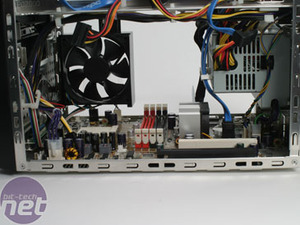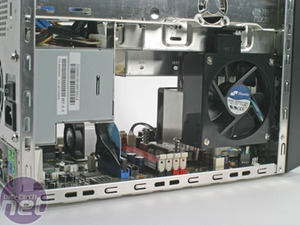Taking the black outer shell off using the supplied thumbscrews reveals that the insides are no longer tool-less. Unfortunately, the upgrade has forced the requirement of a Philips head screw driver to remove the two hard disk racks and then the 5.25" rack underneath. The hard disk racks take individual hard disks; the rear one being cooled by two 60mm fans and the front one has a cut out for a 40mm fan should you feel the need for one. It isn't included, though.
The top racks are also specifically designed for to use SATA hard drives with the cabling specifically routed for data and power connectors. An IDE hard disk can be used, if placed under the disk drive since the IDE cable is capable of handling two IDE devices.



 The actual heatsink is a typical heatpipe design, that uses a 60mm fan to push air through to a 92mm fan and out the case. However, the whole area inside the shroud on top of the CPU core is simply open space! We feel it would have been better use to extend the copper base into an extra heatsink to aid CPU cooling, even if it means a slight redesign having the fan push air in over the heatpipes first to retain efficiency.
The actual heatsink is a typical heatpipe design, that uses a 60mm fan to push air through to a 92mm fan and out the case. However, the whole area inside the shroud on top of the CPU core is simply open space! We feel it would have been better use to extend the copper base into an extra heatsink to aid CPU cooling, even if it means a slight redesign having the fan push air in over the heatpipes first to retain efficiency.
The top racks are also specifically designed for to use SATA hard drives with the cabling specifically routed for data and power connectors. An IDE hard disk can be used, if placed under the disk drive since the IDE cable is capable of handling two IDE devices.


Motherboard Specs
- Support for all socket AM2 AMD Althon 64/X2/FX processors;
- NVIDIA nForce 570 Ultra MCP;
- One PCI-Express x16 and one PCI slot;
- Four DDR2 memory slots with support for up to 8GB of DDR2 800;
- Three internal & one external 3Gb/s SATA ports;
- One IDE port;
- Eight USB 2.0 ports (six rear, two front);
- IEEE 1394a Firewire with two ports (one 4-pin front, one 6-pin rear);
- 7.1 Channel Realtek ALC882 High Definition Audio
- Marvell PCI-Express Gigabit Ethernet



MSI MPG Velox 100R Chassis Review
October 14 2021 | 15:04







Want to comment? Please log in.